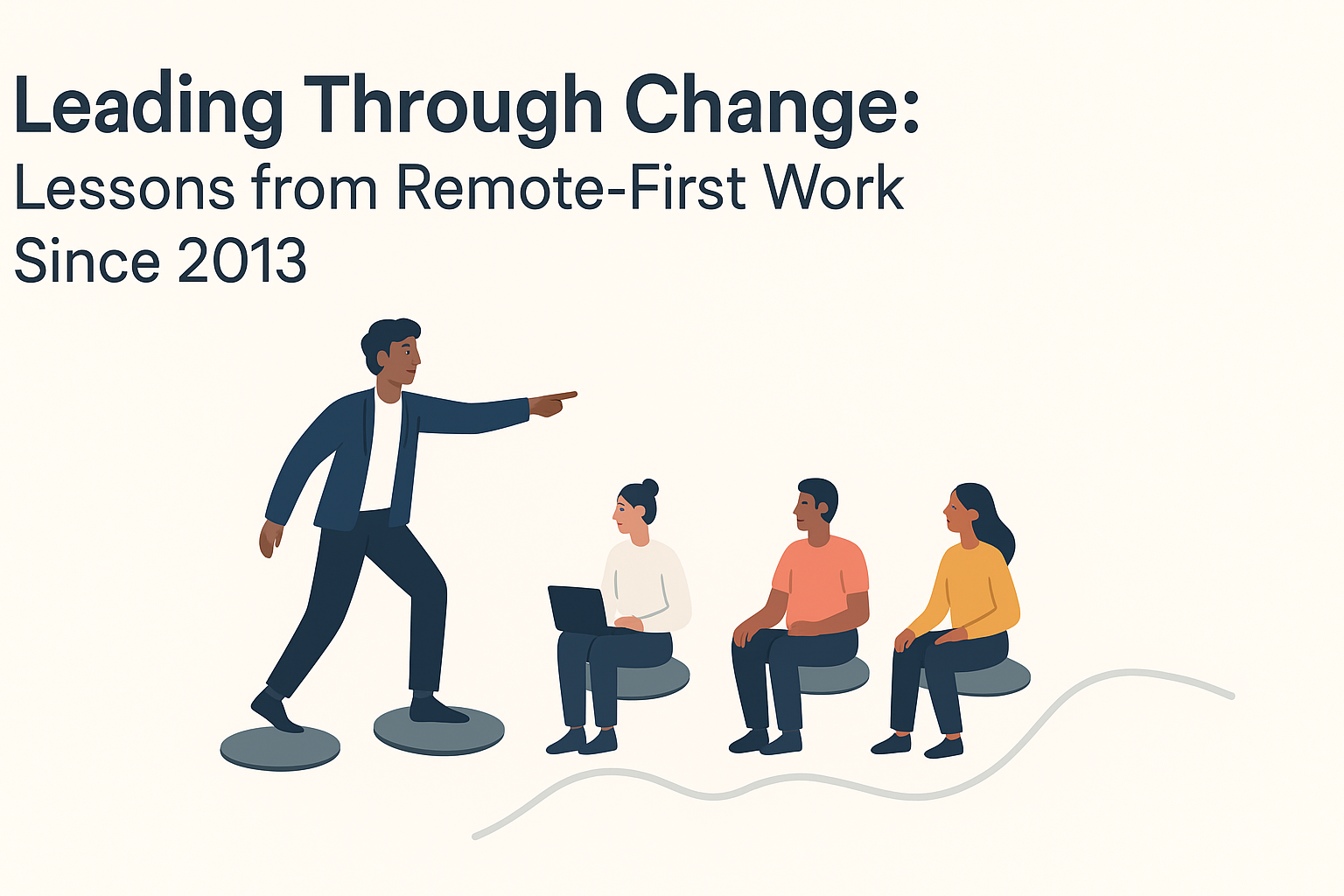Leading Through Change: Lessons from Remote-First Work Since 2013
When people ask me how long I’ve been working remotely, they’re often surprised by the answer: since 2013. Long before “remote-first” became a mainstream phrase, I was already learning the hard lessons of managing distributed teams, navigating time zone challenges, and building trust without physical presence.

Over the years, I’ve seen remote work go from a niche perk to a global necessity. But the real story isn’t about tools or office policies — it’s about leadership and trust. Remote work reshapes how leaders build trust, foster culture, and drive results. Here are the biggest lessons I’ve learned.
The Early Days of Remote Work
Back in 2013, remote work was often viewed as “second class.” Many organizations assumed you had to be in the office to do “real work.” Tools were clunky, and workflows weren’t optimized for distributed teams.
What struck me most was how much leadership had to adapt. You couldn’t just rely on hallway conversations or office energy to keep teams aligned. Every decision had to be deliberate — communication, process, and trust became front and center.
Build Trust Early
The first two months after I transitioned to remote work were a proving ground. A simple “Hi” message in Slack or Teams was often a code for “Are you there?” — team members were checking on my presence. I knew I had to build credibility quickly, so I communicated proactively about my availability, shifted my lunch to align with West Coast hours, and kept my Slack/Teams status indicators up-to-date.
Business Travel
To stay engaged with the team, I initially traveled to the Bay Area office twice a month. After three months, this shifted to once every three months, and eventually, only when needed. Once you’ve built trust and accountability, frequent travel becomes less necessary.
Trust and Accountability in Remote Teams
The biggest leadership shift in remote work is moving from hours to outcomes. In an office, presence can create the illusion of productivity. Remotely, you don’t see hours — you see results.
Some practices that worked well for my teams:
- Document everything: Write down ideas and share them via Zoom or in 1:1s.
- Define outcomes clearly: Use OKRs, design docs, or written goals.
- Separate delivery from monitoring: Leaders should guide and unblock, not hover.
- Trust first: Assume positive intent unless proven otherwise.
When people feel trusted, they often deliver more than if they’re micromanaged.
Communication as a Leadership Skill
Remote work forces leaders to level up their communication game. Without the luxury of ad-hoc conversations, clarity becomes a competitive advantage.
- Writing > Talking: Decisions, rationales, and plans should live in docs or Slack threads, not just calls.
- Consistency matters: Weekly updates, standups, or async check-ins reduce anxiety and keep people aligned.
- Guard against burnout: Being online 24/7 isn’t sustainable. Model boundaries so your team knows it’s okay to disconnect.
In remote leadership, your words are your presence. Use them wisely.
Building Team Culture Without an Office
Culture doesn’t emerge by accident in a remote world — it has to be designed. Some things that helped:
- Create rituals: Regular all-hands, team demos, or even casual coffee chats.
- Celebrate wins publicly: Recognition carries extra weight when people are physically apart.
- Invest in offsites: Nothing replaces occasional face-to-face time. A well-run offsite can strengthen bonds for months. One highlight for me has been celebrating as a team after successfully shipping a project.
The goal isn’t to replicate the office — it’s to create intentional ways of fostering connection.
The Future of Remote Leadership
Today, hybrid models are common, and tools like Slack, Zoom, Notion, and AI copilots are transforming how we work. But the fundamentals of remote leadership haven’t changed:
- Trust outcomes, not hours.
- Communicate clearly, frequently, and in writing.
- Design culture intentionally.
- Be available for critical issues, like system downtime.
The leaders who embrace these principles won’t just survive remote work — they’ll thrive in it.
Closing Thoughts
Remote work isn’t just a setup; it’s a leadership style. It forces you to be more intentional, more trusting, and more human.
After more than a decade of remote-first leadership, my biggest lesson is this: your leadership matters more, not less, when your team is remote.
Comments